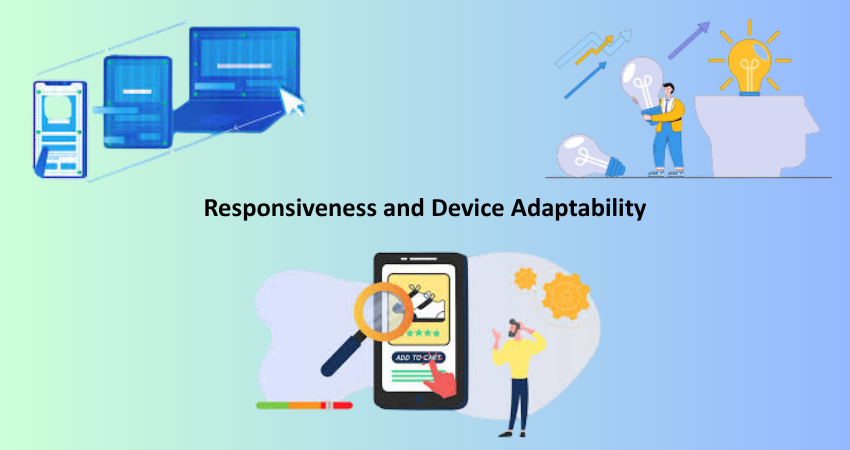
Introduction
When it comes to the online presence of a brand or service, application site is the very first thing that a user may have to see and most probably like to have touched, viewed, or otherwise experienced. What they touch, as well as what they interact with, is solely given to front-end development. Then came the back-end development-the actual life of the system-worked behind the scenes while front-end development brings to the users an intuitive, engaging, and responsive experience. Often, it turns out to be the key factor whether a visitor will stay on the website, perform a transaction, or return at a later time. Front-end development no longer seemed to be just about the aesthetic-something much bigger-it has come to be part of the whole user experience (UX).
Today’s user is no longer satisfied by a website being attractive. They want smooth functioning, reasonable logic, and one experience on all devices, from mobile to desktop, so that everywhere else, from accessibility to navigation and interaction, front-end choices control usability, engagement, and satisfaction. Put simply, without good front-end design, there cannot be a good user experience – however clever the back-end logic or business idea. In this article, a deep exploration of why front-end development is essential in the creation of great user experience will be done about visual functions interactions, responsive techniques, accessibility, branding, and performance.
Visual Design and First Impressions
How Visual Design Influences User Trust
Whether the user visits a website or opens up an app, it is usually the design that creates a first impression. Research suggests it actually takes only a fraction of seconds for a user (often not more than 50 milliseconds) to form an opinion about a website. This judgment takes place almost entirely by visual means, such as layout, colors, typography, spacing, and imagery. When there is no consistency or clarity or it feels outdated, the user will think of that brand as being unprofessional or untrustworthy and does not give importance to the kind of service of the product. This perception takes a toll directly on whether they remain, engage or just leave.
Well-crafted front-end displays increases credibility. The uniform application of a brand’s color palette, professional typography, high-resolution pictures, and a clean layout speak competence and attention to detail. It assures the users that the brand is modern, reliable, and cares about their experience. Besides, attractive design endears the site to the users, making them spend long hours on a site while reducing bounce rates. In the competitive digital marketplace, these are the most significant factors contributing to conversion rates. Clearly, the front-end developer’s ability to implement good visual design has a direct bearing on whether or not users trust, retain, and join a digital product’s success over time.
UI Consistency and Cognitive Ease
Thomas W. Haines explained that consistency in design is not seen only in aesthetic but also goes deep to the understanding with which users perceive information. Name any number of things, and cognitive load is defined as the amount of mental effort used within a system and obviously includes learning new pattern recognition systems or dealing with unpredictable interface structures. An inconsistent button, a strange-named page layout, or unwanted schematics lead users into confusion and effort in achieving goals set. That leads to more frustration, almost dissatisfaction, and more often, abandonment. Front-end development should, therefore, see to it that the user interface is consistent within all parts of the interface so that cognitive load is reduced.
Users speed up their task in familiar environments-feedback loops, with each positive completed task encouraging further use. Because UI consistency helps users create mental models for system operation, they learn and recall its function more easily. It also means that whether first-time visitors or returning after a hiatus, users will have felt in control of the interface throughout their interaction design. With confidence, trust, and loyalty in UX-a trust facilitated by well thought out, consistent front-end implementations.
Responsiveness and Device Adaptability

The Mobile-First Imperative
It becomes a necessity to develop the front end responsively since currently mobile devices are dominating the internet traffic. It’s accessing the web (and applications) through various screen sizes and resolutions-from smartphones to tablets and from desktops to smart TVs. If your digital product doesn’t fit in with these environments, the user experience suffers. The buttons could really be too small to tap on, images might not scale correctly, but above all, the layouts may become disjointed and thus create conditions for flooding users with poor applications to reach disappointing bounce rates and thus missed opportunities for engagement or conversion.
To tackle these issues proactively, mobile-first design has emerged as a front-end strategy where not designing desktop first and then scaling down, but instead developing for mobile first and scaling up has become the norm. This prioritization ensures that the core function and journeys are optimized even for the smaller, touch-based interface use. The use of technology like media queries, flexible grids, and adaptive images will allow front-end developers to construct interfaces that seem native and intuitive across devices. Furthermore, this meets user expectations, as well as the SEO best practices since search engines now rank highly those mobile-friendly websites. Thus, a responsive front-end ensures your UX has device agnosticity, universality, and future-proofing.
Performance on Various Networks and Devices
It is anticipated in the present time that users expect the most instant loading with smooth transactions or interaction without taking into consideration whether one is on a super-fast fiber connection or using mobile data in a remote area. Front-end performance is essential to ensuring that the interaction between the user and a site or application happens quickly and smoothly, even under the most unfavorable circumstances. It helps to reduce page load times and improves overall responsiveness through the optimization of front-end code, that is, efficient handling of CSS, JavaScript, and images. An interface that is slow frustrates the user, reflecting a lack of professionalism, which destroys the experience with the brand.
A front-end developer especially improves a web application based on performance if they maximize on best practices such as lazy loading, keeping DOM complexity to the minimum, compressing images, and reducing the use of third parties. Lightweight frameworks and static site generators allow faster rendering. Progressive enhancement techniques keep basic functions accessible to users even when advanced features fail to load. The users’ satisfaction and confidence increase when they perceive the app/website is rendering well under varied conditions. Responsiveness and performance of front-end solutions show that this brand cares about the user’s time and accessibility needs, which is a foundation to a great user experience.
Accessibility and Inclusivity
Making the Web Usable for All
All front-end efforts are dedicated to making websites and applications usable for people with all kinds of disabilities, including those with visual, auditory, motor, or cognitive impairments. Accessibility should not be regarded merely as a technical requirement or a matter of legal obligation; it is a moral necessity; this very concern constitutes the cornerstone of user experience design. One must understand that user experience-for it to be called great-should be inclusive, implying that every human being ought to be able to perceive, navigate, and interact with one’s digital content irrespective of ability. This goes into the front-end, where one would provide accessibility duties by means of semantic HTML and ARIA roles, keyboard navigation, and screen reader support.
Accessibility of the front-end offers an interface that is simple to use for everyone, not only those with disabilities. For keyboard users, a definite focus state makes a real difference. Color contrast is essential for all users, especially those with visual impairment. Good alt text is an advantage for SEO and also assists screen readers. This inclusiveness ultimately results in a user interface that anyone can interact with. Inclusive design gives you more audience, creating goodwill. Front-end developers are really elevating their craft to the level of being more human-centered, considerate, and fair—elements of a truly excellent user experience.
Compliance, SEO, and Legal Implications
Lack of consideration for accessibility can result in dire consequences beyond just a poor user experience. The accessibility would not only affect the site in itself but it is also considered legally enforceable in many areas, such as the U.S., U.K., Canada, and the European Union, because of laws like the Americans with Disabilities Act (ADA) or by the Web Accessibility Directive. Not keeping up with the accessibility standards such as WCAG 2.1, websites can be sued and fined. This is where public condemnation comes in. In terms of risk management, front-end accessibility is a necessity, a strategic must; because failure means brand reputation risk and maybe even legal liability.
Moreover, SEO is complemented by accessibility. Search engines favor structured and semantic HTML for improved crawling and indexing. Alt tags, appropriate headings, and accessible navigation all contribute to improved search rankings. Therefore, any accessibility enhancement on the front end improves user experience for all folx while enhancing search visibility. When users with disabilities can interact with your site just like any other typical user, your brand stands for inclusion, quality, and sustainable growth. Ethical front-end development obviously translates into profitability.
Interactivity and User Engagement

Smooth Navigation and Intuitive Controls
The established front end is under complete control for the navigation, which is the most critical feature of user experience. An effective navigation system will help the user find the information in as less confusion or clicking as possible. This is done through correctly labeled menus, well-placed call to action buttons, breadcrumb navigation, and a common layout for navigation. When users know where they are and where to go, Navigation provides them with a common-sense approach to an amazing experience, whereas with bad Navigation, user irritations will contribute directly to increased bounce rates and bad brand impressions.
Frontend developers polish usability through JavaScript frameworks and libraries for dynamic, interactive experience-building. For instance, a simple application built with React, Vue, or Angular can still perform without leading to complete page reloads. Modals, dropdowns, sliders, and similar interactive traits are developed with a great deal of usability and performance concern. The crux of the matter is how to keep its functionality without rendering users under unnecessary complexity. Thus, navigation and interacting should be intuitive, instant, and purposeful. Good front-end actualizing makes users feel very encouraged to explore your site, complete tasks, and return with confidence.
Feedback Loops and Microinteractions
Microinteractions might be considered slight, nearly unnoticeable design details that assure and reassure users along their paths. Button animation, color change on hovering, and submission loading indicators are examples of microinteractions. The tiniest detail can give a user under extreme psychological pressure feedback and create a sense of control. When the design lacks these elements, the site may seem dead or inactive, causing users to wonder whether their clicks had been registered. On the front end, such interactions must be crafted, so they appear smooth, performant, and accessible.
Feedback loops through which a user can be encouraged and even inducted into emotional experiences are excellent. For example, showing a message to say that a form has been submitted or animating a shopping cart icon whenever an item is added adds up to a pretty fulfilling experience. These interactions reduce the ambiguity in decision-making and build trust. All these contribute to the brand personality by making the product feel more polished and user-centric. Front-end developers are preferably trained to work along with UX designers to integrate such delightful experiences into the usage of an application. Micro-interactions may be insignificant; however, their great contribution made the levels of user satisfaction attain very high standards and thus deemed critical in front-end strategy.
Conclusion
Front-end web design is no longer a secondary part of digital product design; it is now integral to great user experience. Everyone talks about how the look and feel of a product, mobile responsiveness, accessibility, interactivity, and performance are but only a few elements behind the whole front-end-built perception of a brand from the users’ standpoint. A little bit depends on how they perceive and use the entire product. Most of the time, they do not see its backend- the wheels that power it but the buttons, forms, animations, and layouts. When these fall short of expectations, the whole product suffers, regardless of the premium technical prowess put in behind the curtains.
Top-class front-end development would connect the science of technology with the psychology of the human being. It makes systems usable, inclusive, fast, and delightful across all platforms and all users. Whether creating a website for a startup or an online global buying platform, ensuring top-notch front-end development means investing in user trust, involvement, and loyalty. In the post-covid digital economy, business establishments can no longer treat the front-end as an afterthought. Without a doubt, it contributes significantly to the success of your digital persona, as well as to making a user experience great.